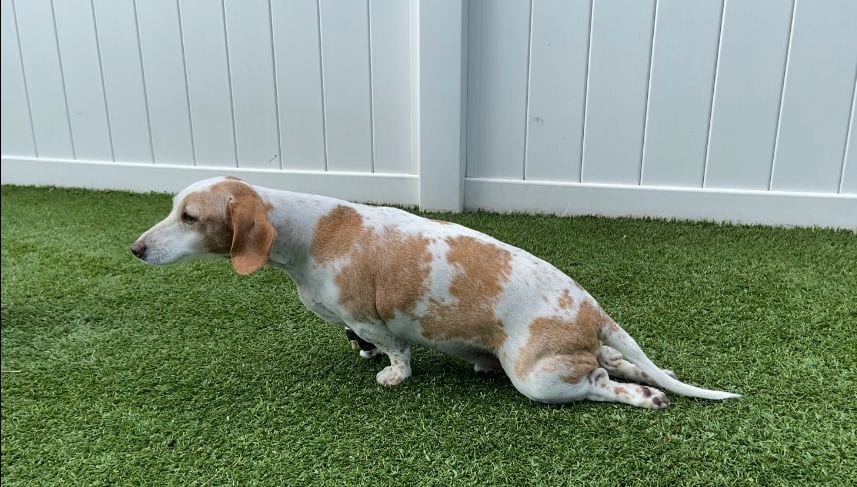It’s ruff to watch someone we love suffer – especially when that someone can’t tell us what’s wrong. So it’s our job as pet parents to look for clues. Is your dog holding its head low or yelping when touched? Walking wobbly or dragging its limbs? Your poor pup might have back pain… and may need to see a veterinary neurologist about IVDD in dogs.
IVDD in Dogs
There are several possible causes of back pain in dogs, but intervertebral disc disease (IVDD) is the most common spinal cord disorder in dogs and one of the most common disorders in neurology. It most often arises mid-back (thoracolumbar), but IVDD in dogs can show up anywhere along the spine, from neck (cervical) to lower back (lumbosacral). It is somewhat common as part of the normal aging process, but certain breeds are more prone to be affected earlier in life, like:
- Dachshunds
- French Bulldogs
- Pekingese
- Shih Tzus
- Beagles
Sadly, some of the breed traits that make our furry friends so lovable also make them susceptible.
What is IVDD in Dogs?
Spinal vertebrae are connected and protected by discs containing soft, jellylike centers. Intervertebral disc disease occurs when these once spongy, shock-absorbing discs dry out and harden, leading to bulging or rupture. You may have heard IVDD referred to as:
- Bulging disc
- Slipped disc
- Herniated disc
- Ruptured disc
The result is pressure on the spinal cord, causing an array of symptoms ranging from mild pain to permanent paralysis.
Preventing IVDD in Dogs
Although IVDD in dogs is generally a gradual degenerative disease that cannot be prevented, it often surfaces in a younger dog from an event resulting in sudden loss of mobility. Some things you can try at home to prevent a spinal injury in a predisposed breed are:
- Keep your dog at a healthy weight
- Use a harness instead of a neck collar
- Curb jumping on and off furniture
- Limit high impact activities
- Avoid playing tug-of-war
However, when all is said and done, the single most important thing you can do is seek professional veterinary care as soon as symptoms appear.
Symptoms of IVDD in Dogs
Symptoms can range from pain to paralysis, and while there are five defined stages of IVDD in dogs, the progression is not necessarily linear. For example, a dog may show signs of a more progressive stage without ever having shown signs of the first stage. Dogs can absolutely recover from intervertebral disc disease, but without timely treatment, it can cause permanent damage. The sooner it is attended to, the better the prognosis.
Here are some warning signs of IVDD in dogs to be aware of in your canine companion from least to most severe:
- Lowered head when standing
- Arched or hunched back
- Stiff neck or limbs
- Reluctant to move
- Shivering, shaking, or muscle spasms
- Whining when moved or touched
- Wobbling, incoordination, or weakness when walking
- Paw knuckling (dragging paws)
- Inability to walk
- Paralysis of limbs
- Incontinence
- Loss of feeling in limbs
How is IVDD in Dogs Diagnosed?
If you notice any of the warning signs above, immediately limit your dog’s activity to crate rest until you can get to a veterinary neurologist. If your dog has already lost the ability to move, please don’t wait. Each hour is critical to its recovery. At Southeast Veterinary Neurology, we are ready to help 24 hours a day, seven days a week.
To diagnose IVDD in dogs, a veterinary neurologist will first conduct physical and neurological exams to rule out other conditions. If your dog is suspected to have IVDD, advanced imaging is recommended for an accurate diagnosis. MRI (Magnetic Resonance Imaging) is the best way to confirm that a dog has intervertebral disc disease.
Treatment of IVDD in Dogs
IVDD in dogs can be treated either medically or surgically, depending on the stage of the disease. For first-time sufferers in the early stages, treating intervertebral disc disease with some combination of cage rest, pain medications, anti-inflammatories, and muscle relaxers can be effective. However, if your dog is not responding to these treatment options, is having reoccurring episodes, or is experiencing severe symptoms from a more advanced stage of IVDD, surgical intervention is necessary.
The goal of IVDD surgery is to relieve spinal cord compression, and its advantages over medical treatment are its completeness and speed of recovery. Surgery is quite successful in the hands of a trained veterinary neurosurgeon. At Southeast Veterinary Neurology, our highly skilled neurologists also perform a preventative procedure during the operation to reduce the likelihood of reoccurrence, which is a concern with intervertebral disc disease.
Caring for a Dog with IVDD
The prognosis for IVDD in dogs depends on the severity of the disease and the timeliness of the intervention, but in most cases, your best buddy can live a long and happy life with a little extra help from you, your veterinary neurologist, and in some cases, adaptive equipment such as a dog wheelchair.
At Southeast Veterinary Neurology, we understand the last thing you want to see is your dog in pain. That’s why the first thing you should do is call us. The earlier intervertebral disc disease is diagnosed and treated, the better the chances are of your favorite “person” making a full recovery. We’ve got your dog’s back!
Posted in IVDD

